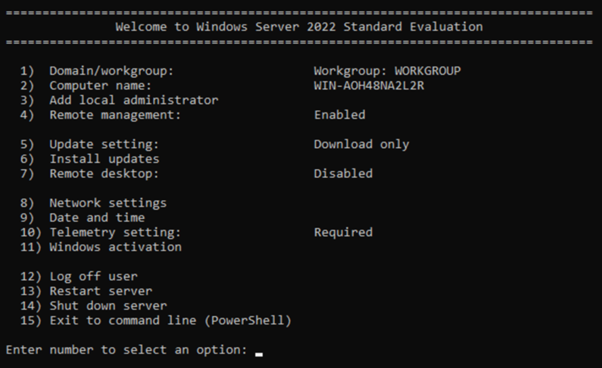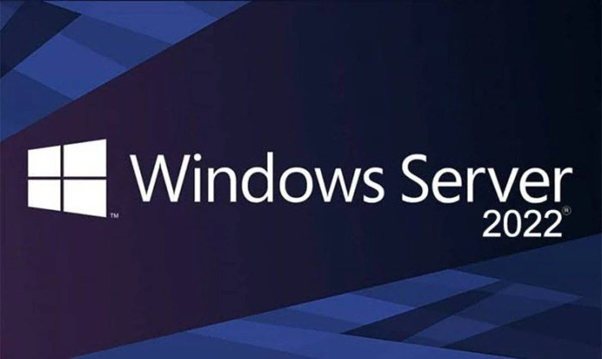Windows Server 2022 is the latest version of Microsoft’s server operating system, designed for use in enterprise IT infrastructures. This OS offers numerous new features and improvements compared to previous versions, including enhanced security, support for containers and Kubernetes, simplified management, and expanded options for working with the Azure hybrid cloud.
In this article, we will introduce you to the key characteristics of Windows Server 2022 Standard and provide a step-by-step installation guide for this OS from scratch.
Preparation for Installation
Before you download Windows Server 2022 Standard ISO from Microsoft’s official website, it is necessary to ensure that the server meets the minimum system requirements:
- Processor with a clock speed of at least 1.4 GHz (2 GHz or higher recommended).
- RAM: minimum 512 MB (2 GB or more recommended).
- Disk space: minimum 32 GB.
You should determine the type of installation — this can be a clean installation on a new server, an upgrade from a previous version of Windows Server, or a migration of roles and settings from an old server.
It is important to check the compatibility of the server hardware and its components with Windows Server 2022, especially regarding network adapters, storage controllers, and other specific devices. If necessary, download the latest versions of drivers from the manufacturers’ websites.
For installation, you will need bootable media with the Windows Server 2022 Standard distribution. This can be created from an ISO image downloaded from the Microsoft website or obtained through a subscription. The easiest way is to use a USB flash drive with a capacity of at least 8 GB, formatted in the FAT32 file system.
Step-by-Step Guide to Installing Windows Server 2022 Standard
The software installation is straightforward and requires only eight steps:
- Connect the bootable media to the server and turn it on. When the welcome screen appears, press any key to start the installation.
- Select the language, regional standards, and keyboard layout. Click “Next”.
- On the installation screen, select the “Install now” option. Enter the product key if you have one. For an evaluation installation, you can skip this step.
- Accept the license agreement terms and click “Next”.
- Choose the installation type. Clean installation: removing all partitions and installing Windows Server on an unformatted disk. Upgrade: preserving files, settings, and applications from the previous version of Windows Server.
- Specify the target disk for system installation, format it if necessary, and create partitions.
- Wait for the installation process to complete, after which the server will automatically restart.
- At the first boot, enter the local administrator password and configure basic security settings.
At this point, the basic installation of Windows Server 2022 Standard is complete, and the system is ready for initial configuration for specific tasks.
Activating Windows Server 2022 Standard
After installing Windows Server 2022 Standard, it is necessary to activate the system to gain access to all features and updates. This requires a valid product key, which can be purchased from Microsoft or its official partners. If you already have a product key, activation can be performed from the command line:
- Run the command prompt as an administrator.
Enter the following command, replacing XXXXX-XXXXX-XXXXX-XXXXX-XXXXX with your product key:
Dism /online /Set-Edition:ServerStandard /ProductKey:XXXXX-XXXXX-XXXXX-XXXXX-XXXXX /AcceptEula
- Wait for the activation process to complete. It may take several minutes.
After the successful activation of Windows Server 2022 Standard, you can fully utilize all system capabilities and receive security updates from Microsoft.
Initial Server Configuration After Installation
After installing Windows Server 2022 Standard, it is recommended to perform a series of basic configurations:
- Install the latest security updates and critical updates through Windows Update.
- Configure basic network parameters: static IP address, subnet mask, gateway address, preferred and alternate DNS servers.
- If necessary, join the server to an Active Directory domain.
- Install the Windows Server roles and features required for the intended use: file services, print services, Hyper-V, and the IIS web server.
- Configure remote access to the server via the RDP protocol. For increased security, use a non-standard port and restrict access to IP addresses.
Grafana and Prometheus are the popular stacks for server monitoring and metrics collection. They can be deployed as Docker containers using ready-made images from the Docker Hub.

Conclusion
Windows Server 2022 Standard is a modern and functional server OS, ready for the challenges of digital business transformation. Thanks to new security features, container support, and Azure integration, it allows IT professionals to create more reliable, scalable, and manageable infrastructures.
After installation and initial configuration of Windows Server 2022 Standard, it is recommended to study the documentation on deploying core services and optimizing performance in more detail. It is also worth considering migrating part of the workload to the Azure cloud to increase availability and conserve resources.
Microsoft offers numerous educational resources allowing IT professionals to use Windows Server 2022 capabilities more effectively and integrate this OS into modern hybrid environments:
- Official documentation for Windows Server 2022 is available on the Microsoft Docs website.
- Practical lab work on configuring various Windows Server 2022 components in Microsoft Learn.
- Courses to prepare for certification exams for Windows Server on the Microsoft Learn platform.
With the right approach to implementation, Windows Server 2022 Standard can become a reliable foundation for digitizing business processes and transitioning to flexible and fault-tolerant IT infrastructures in the era of cloud computing and edge devices.
Caroline is doing her graduation in IT from the University of South California but keens to work as a freelance blogger. She loves to write on the latest information about IoT, technology, and business. She has innovative ideas and shares her experience with her readers.





![‘Frankenstein’ Review – Guillermo del Toro’s Definitive Look At The Nature And Nurture Of Monstrosity [TIFF 2025] ‘Frankenstein’ Review – Guillermo del Toro’s Definitive Look At The Nature And Nurture Of Monstrosity [TIFF 2025]](https://cdn.geekvibesnation.com/wp-media-folder-geek-vibes-nation/wp-content/uploads/2025/10/Frankenstein-175_PF_20240430_20377_R-300x200.jpg)
![‘Wake Up Dead Man: A Knives Out Mystery’ Review – In Rian Johnson We Trust [LFF 2025] ‘Wake Up Dead Man: A Knives Out Mystery’ Review – In Rian Johnson We Trust [LFF 2025]](https://cdn.geekvibesnation.com/wp-media-folder-geek-vibes-nation/wp-content/uploads/2025/10/Wake-Up-Dead-Man-A-Knives-Out-Mystery-300x169.jpg)